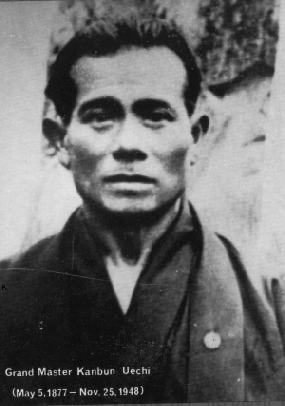The History of Uechi-Ryu KarateDo
Uechi-Ryu KarateDo was originally a form of Chinese Boxing - one of the Pangai-noon ('half-hard, half-soft') styles. According to one researcher, its formal name may have been 'Nan-Pa Toro Ken' - South Group Mantis Fist. This system combined the movements of the tiger, dragon, crane, leopard, snake, mantis, and cobra.
Grandmaster Kanbun Uechi was responsible for bringing this art out of China. Kanbun’s decision to teach allowed the system to spread worldwide, thus preserving the original style and many variations for all to study. According to Sensei Seiko Toyama (a direct student of Kanbun), Kanbun Uechi never told the true old name of the system he studied in China, but simply named it 'Pangai-noon-Ryu Karate-Jutsu'.
Kanbun Uechi was an Okinawan Samurai descendent, born on 5 May 1877 in Izumi, a small village on the Motobu peninsula of northern Okinawa.

As a young man, Kanbun left Okinawa for China to avoid conscription in the Japanese Army, to study Chinese Cong Fu, and to further business prospects for his family’s herbal medicine trade. His resolve to study fighting arts in China was inspired by incredible tales of the fighting skills and feats of the Chinese masters as told to him by an old karate master named Toyama, who had traveled frequently to China to study such arts. Kanbun was already proficient with the Bo (staff) and had excelled in the karate training of his village, but these stories fired his imagination and made him thirsty for new and deeper training. So, in March 1897, nineteen year old Kanbun Uechi left Okinawa for China to seek fulfillment of his dream of becoming a true warrior.
In Foochow, a major city of the Fukien Province of China, just west of the northern tip of Taiwan, Kanbun met a young Taoist priest named Shuu Shiwa, a master of Chinese Boxing. Among other styles, Shuu Shiwa taught his family system of Cong Fu which, according to research, may have been created by an ancestor approximately 200 years prior, the monk Shuu Anan.
Kanbun studied every day for ten years, and became a master of the Shuu Family Style. His training with Shuu Shiwa extended beyond fighting skills - Kanbun also deepened his already considerable knowledge of the healing arts, and made medicines which he sold to help pay his tuition with Sensei Shuu. Eventually, he earned permission to teach, and opened his first school in Nansoue, about 250 miles west-northwest of Foochow. He taught there for nearly three years.
Near the end of that time, an unfortunate incident occurred in which a technique from the Shuu Family Style was accidentally misapplied and a man was killed. Kanbun felt completely responsible for the death, and so closed his school and left China, vowing to never teach Cong Fu again. The year was 1910. It is probable that Kanbun Uechi was the only Okinawan who ever taught Shuu Family Style Cong Fu in China.
After his return to Okinawa, Kanbun married and settled down to a life of farming. His son Kanei was born on 26 June 1911. Other children followed, and the Uechi family grew. Kanbun still refused to discuss his skills in Cong Fu or his life in China. After seventeen years of silence, he was finally convinced to share his art once again. He had left Okinawa in 1924 for employment in Mainland Japan, in the Wakayama Prefecture near Osaka. His first non-family student was an Okinawan named Ryuyu Tomoyose, who lived in the Okinawan compound in Wakayama close to where Kanbun lived. The year was 1927. Within a few years, Kanbun and his senior students established a highly reputable dojo. Kanbun taught full time, and also made and sold the medicinal compounds he had learned from his father using herbs he brought from China. By that time, the art of fighting without weapons was becoming known as karate - “Empty Hand” - which had previously been known as “Chinese Hand” (in Japanese Kanji, 'kara' can have two meanings - one means 'chinese', the other means 'empty').
When Kanei was sixteen years old and in ill health (1927), he joined his father in Wakayama and began to learn the art of 'Pangai-noon-Ryu Karate-Jutsu' - half-hard, half-soft style, empty hand technique. He regained his health, and became proficient enough to establish his own Osaka dojo in April 1937, moving it to Hyogyo a short time later.
In 1940, Kanbun renamed the system 'Uechi-Ryu Karate-Jutsu'. In 1942, Kanei returned to Okinawa and began teaching in his home dojo in Nago. Kanbun returned to Okinawa in 1947, and moved to Ie Jima, an island just off the northwest coast of Okinawa. He died there on 25 November 1948, losing his agonizing battle against nephritis. Kanbun Uechi was 71 years old. After his death, the art was renamed Uechi-Ryu KarateDo (Uechi’s method of the Way of Karate).
Kanei Uechi continued to teach a modified version of his father’s art for the remainder of his life, and was eventually considered one of the world leaders in the field of karate development, instruction, and popularization. In the early 1950’s, he moved the dojo to Ginowan, and later to Futenma (1956). He passed away in early 1991 after a lengthy hospitalization and a long term of illness. Kanei Uechi was 79 years old, and had achieved 10th Dan. There are now approximately 50 or more associations on Okinawa directly related to Uechi-Ryu, all teaching slightly different but equally valid styles of the same system.
Note: The history of Uechi-Ryu described on this page is from writings of G. Seizan Breyette and is used on this site with his permission.


